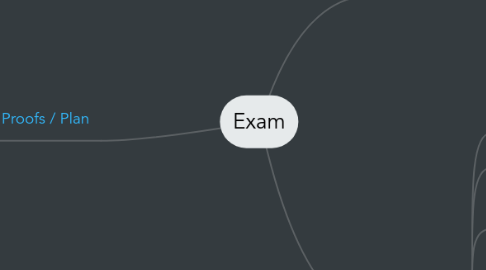
1. Proofs / Plan
1.1. Split-half, Odd-even, Kuder-Richardson: Twice the correlation between two halves, divided by one exam half plus one is my whole test: what is my correlation between the two halves, if any?
1.1.1. This document describes our Go To Market Plan for <Product Name>.
1.2. What is my Obtained score? Is my True score representative of my expected margin of error?
1.3. What is the difference between my projected true score and my obtained score?
1.4. Is it content-, delivery-, study-, instruction-, or student-related?
1.5. Does exam reliability accurately reflect standard deviation? Why, why not? Will converting raw scores bump student performance, and if so, does this change any perceived correlations between performance and established theories?
1.6. How strong is/are my correlation(s)?
1.6.1. Training
1.6.2. Channels
1.6.3. International
1.6.4. Public Sector
1.6.5. Sales
1.6.6. Marketing Communications
1.6.7. Product Management
2. Reliability
2.1. Test-retest: What correlations, if any, do I seek between the two exams?
2.2. Time: Will intervals affect the consistency of my results and exam integrity? If so, what are my options and risks associated with reprieves between exam administration?
2.3. Are my students' scores consistent? Why, or why not?
2.4. Are alternate / equivalent exams available? Are they necessary? What are my criteria for developing tests to weigh against each other?
2.5. What am I testing? Are all of the exam items similar?
3. Validity
3.1. What do I want it to measure?
3.1.1. Situational Analysis / Drivers
3.1.1.1. What is driving us to do this?
3.1.1.2. SWOT Analysis
3.1.1.2.1. Strengths
3.1.1.2.2. Weaknesses
3.1.1.2.3. Opportunities
3.1.1.2.4. Threats
3.1.1.3. Customer Findings - What have we learned from customers?
3.1.2. Competitive Analysis
3.1.2.1. Do we have competitors and threats in these target markets with the proposed offerings?
3.1.2.2. What are our competitors doing and how are they positioning?
3.1.2.3. How do we position against each competitor?
3.1.3. Target Customer(s)
3.1.3.1. Buyer Profile
3.1.3.1.1. Title
3.1.3.1.2. Industry
3.1.3.1.3. Geography
3.1.3.1.4. Business Size
3.1.3.2. Influencer Profile
3.1.3.3. User Profile
3.1.3.4. What do customers want and need?
3.1.3.5. What business problems do each of these customers have?
3.1.4. Customer Segmentation
3.1.4.1. Which customers or sets of customers do we sell to?
3.1.4.2. What are the target market segments that we want to go after?
3.1.4.3. What are the distinct problems for each segment of the market?
3.1.5. Total Available Market
3.1.5.1. New Prospects
3.1.5.1.1. How much of each target segment have we penetrated?
3.1.5.1.2. How much opportunity is available in each target segment?
3.1.5.2. Existing Customers
3.1.5.2.1. Can we up-sell existing customers?
3.2. What DOES it measure?
3.2.1. Service Offer
3.2.1.1. What are we selling?
3.2.1.2. Product Definition
3.2.1.3. Pricing
3.2.1.4. Packaging
3.2.1.5. Positioning
3.2.2. Value Proposition
3.2.2.1. What is the Value Proposition to the Customer?
3.2.2.2. What pain are we solving?
3.3. Content Validity Evidence: Are my designs on achievement, aptitude, or behaviour (Kubiszyn & Borich, 2013, p. 327)?
3.3.1. Revenue Forecasts
3.3.1.1. Revenue and P&L Forecast (5 Years)
3.3.1.2. Revenue should be split out quarterly
3.3.2. Cost Analysis
3.3.2.1. Should include a description of the costs in entering this business and profitability analysis
3.3.3. Profitability Analysis
3.3.3.1. P&L for the offer to include gross margin, net income and break even analysis.
3.4. Predictive Validity: By design, can I accurately predict traits or behaviours of my students taking this exam (p. 328)?
3.4.1. Sales Strategy
3.4.1.1. Direct Sales Strategy
3.4.1.2. Inside Sales Strategy
3.4.1.3. Channel Sales Strategy
3.4.2. Partner Strategy
3.4.2.1. Channel Strategy
3.4.2.1.1. What 3rd party channels should we consider for reselling this service?
3.4.2.2. Technology Partnerships
3.4.2.2.1. What technology vendors (if any) do we need to work with to execute on this plan?
3.4.2.3. Solutions Partners
3.5. Concurrent Criterion: Do I have a numerical index correlating behaviours or performance of established tests with my new exam?
3.5.1. Positioning & Messaging
3.5.1.1. What is the key messaging and positioning for the service offer? (Pain, alternatives, solution)
3.5.1.2. How do we communicate internally?
3.5.1.3. How do we communicate externally?
3.5.2. Promotion Strategy
3.5.2.1. Marketing Programs (Installed base versus new prospects)
3.5.2.2. Advertising (Publications, etc.)
3.5.2.3. Analyst Relations (Target Analysts)
3.5.2.4. Public Relations
3.5.2.5. Events (Trade shows, SEO/SEA, Seminars)
3.5.2.6. Webinars
3.5.3. Demand Generation & Lead Qualification
3.5.3.1. How do we generate and qualify new leads for the target offer?
3.5.3.2. Prospect Lists
3.5.3.3. Key Questions to Ask
3.5.3.4. Sales Collateral
3.5.3.5. Presentations
3.5.3.6. Data Sheets
3.5.3.7. White Papers
3.5.3.8. ROI Tools
3.5.3.9. Other Sales Tools (web site, etc.)
3.6. Construct Validity: Is exam criteria or student performance on this exam corroborated by established theory?
3.6.1. Numbers, budget, waterfall, break-even (cost>leads>trials>deals)
3.6.2. Sales Programs
3.6.3. Accelerated Learning Strategy, Controls, Metrics
3.6.4. Include feedback loops
3.6.5. Include financial metrics (definition of success)
3.6.6. Pipeline reports, etc…
3.7. Ruling of Concurrent Validity (cont'd): Does my exam application require a set time frame of administration, or interval(s) between administration, to yield measurable results?
3.7.1. M&A?
3.7.2. Risk Analysis & Mitigation
